Who can resist delicious crispy homemade vegetable tempura? When making tempura at home, the goal is a crispy yet airy coating that doesn’t absorb oil when deep-fried. I’ll teach you how to achieve excellent results in this recipe.
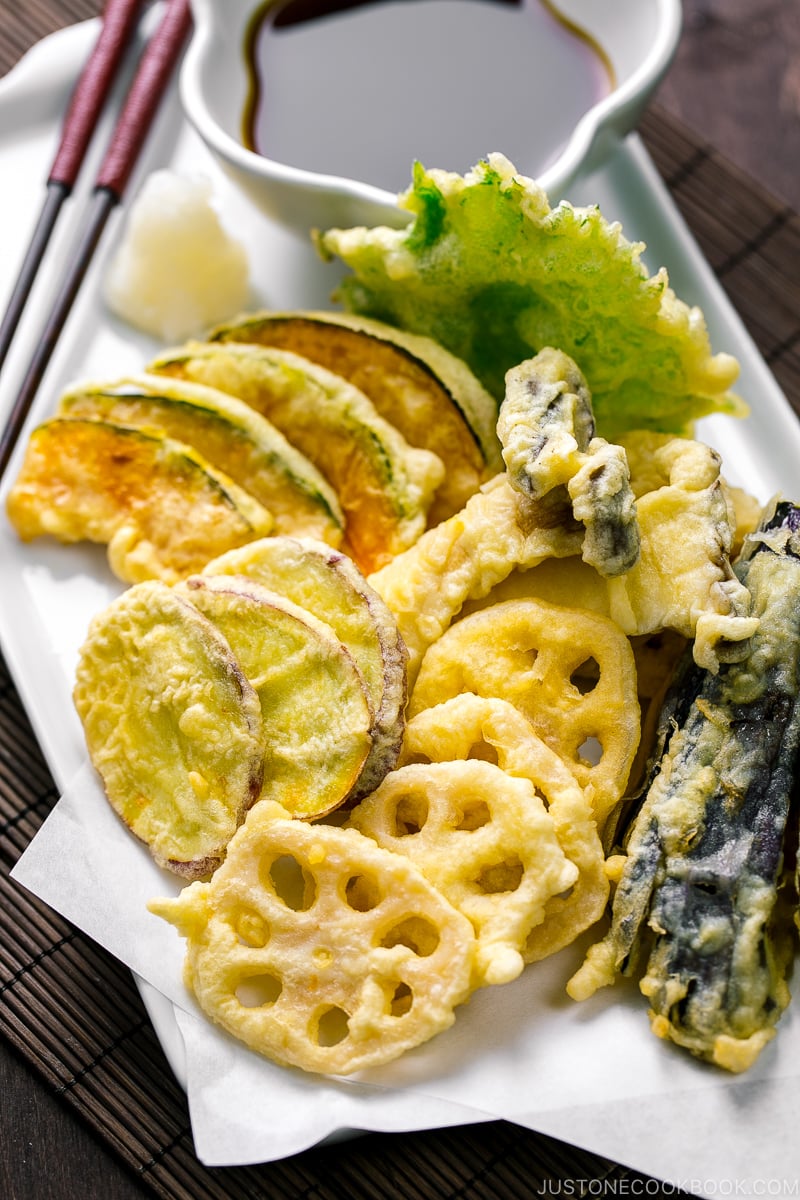
Alongside sushi and ramen, tempura is another mandatory menu item for Japanese restaurants. Encased in a crunchy, crispy yet light batter, these perfectly deep-fried seafood, and vegetable are seriously addicting.
After sharing my Shrimp Tempura recipe, I am excited to share today’s recipe on Vegetable Tempura (野菜の天ぷら) since many of you have requested it. Dipped in batter and deep-fried, each vegetable gets cooked perfectly on the inside, while the natural sweetness and flavor are enhanced. You would enjoy them piping hot with a delicate dipping sauce with grated daikon.
Some of the common vegetables used for Tempura include Japanese sweet potatoes, mushrooms (shiitake or king oysters are delicious), Kabocha squash, bell peppers, lotus roots, and eggplant. When I make vegetable tempura at home, I also like to include shiso leaves as well.
Table of Contents
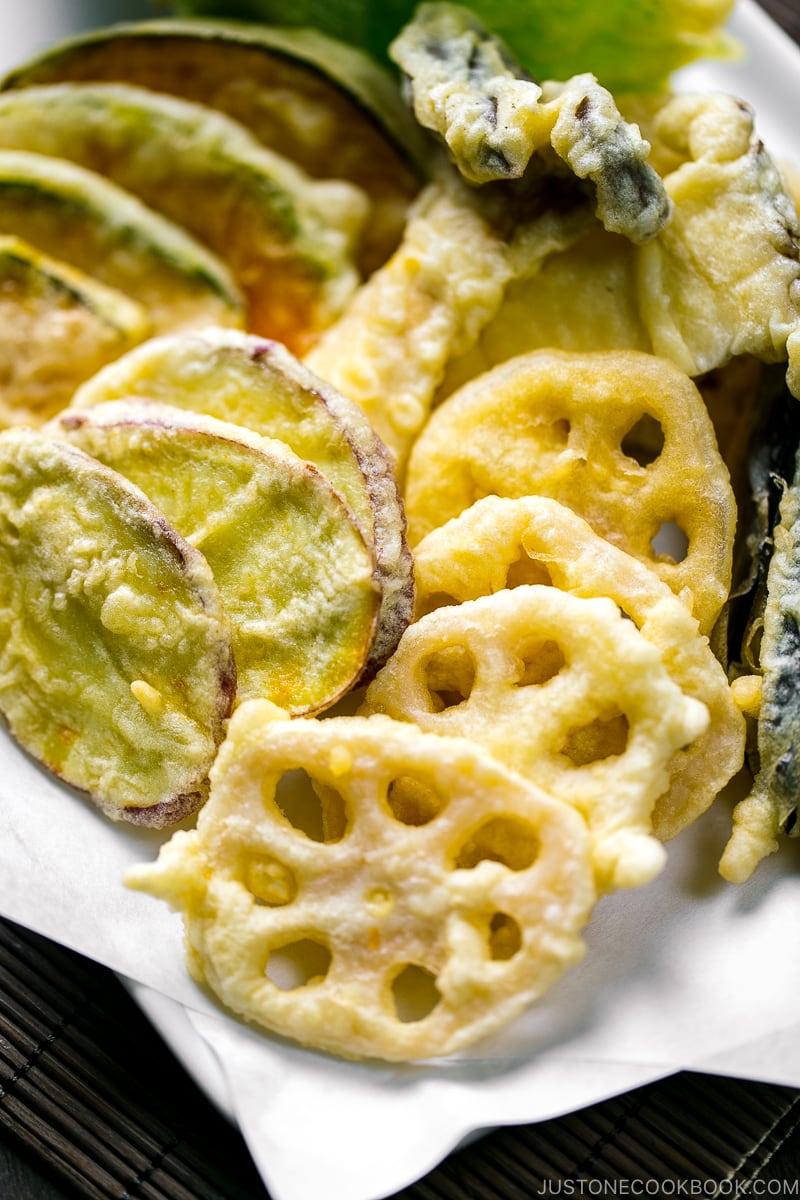
The Key for Perfect Vegetable Tempura
Before I start talking about how to make Tempura, please understand that even for the Japanese, making perfect Tempura is not easy. It requires a lot of skills and practice so don’t be discouraged if your first tempura does not look like ones from restaurants. But how do you get that crispy texture without the food being too oily?
The key to perfect tempura is the batter and the temperature of the oil. I created a few steps below to go over the tips for making tempura.
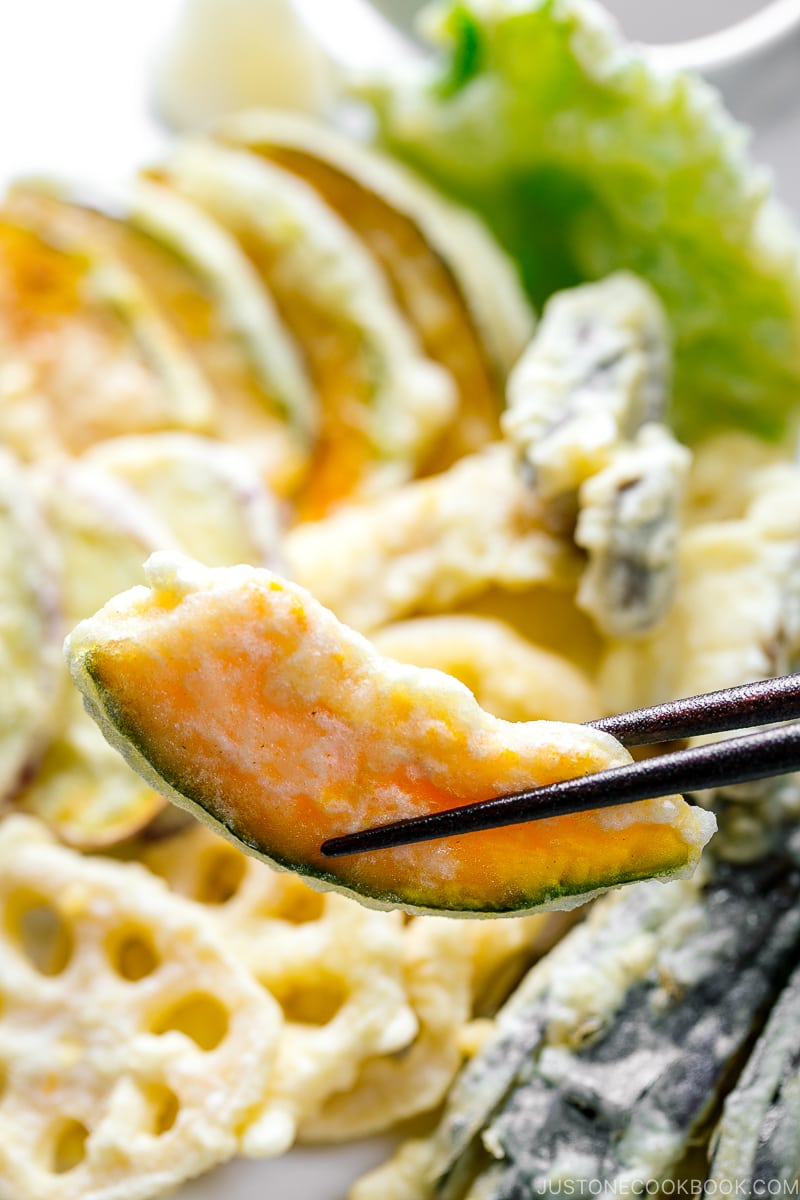
Vegetable Tempura Cooking Tips
How to Make Tempura Batter
Most of Tempura chefs recommend that flour to water ratio should be 1:1. Some recipe requires an egg (or two depending on the amount of flour and water), and some don’t. It’s up to you. When the batter is too thin, the ingredients won’t have much of batter around it and there is no fluffy and crisp texture to it. When the batter is too thick, you feel like you are eating the chewy exterior.
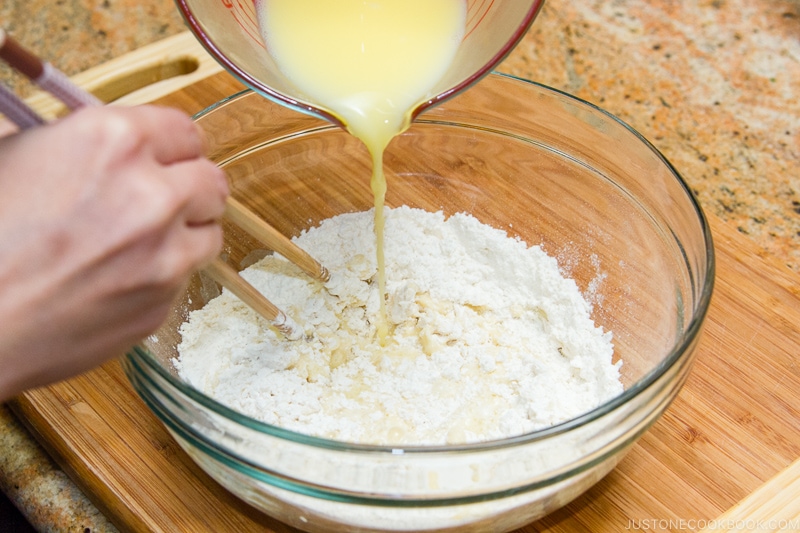
Please remember a few tips about the batter. Always mix the batter using chopsticks for only a few seconds to at most 1 minute, leaving lumps in the mixture on purpose. Overmixing the batter will result in the activation of wheat gluten, which causes the flour mixture to become chewy and dough-like when fried.
The cold batter is absolutely necessary for the unique fluffy and crisp tempura. All the ingredients (water, egg, and flour) must be cold prior to making the batter, and it has to be made RIGHT BEFORE you deep fry and has to be kept cold at all times to avoid activation of wheat gluten.
What Oil To Use for Tempura
The Tempura specialty restaurant uses untoasted sesame oil (clear) or a special blend of oil that is a combination of many kinds of oil. Each restaurant has its own secret recipe and blends that they perfected over the years. At home, you can simply enhance the flavor by adding sesame oil into the vegetable oil.
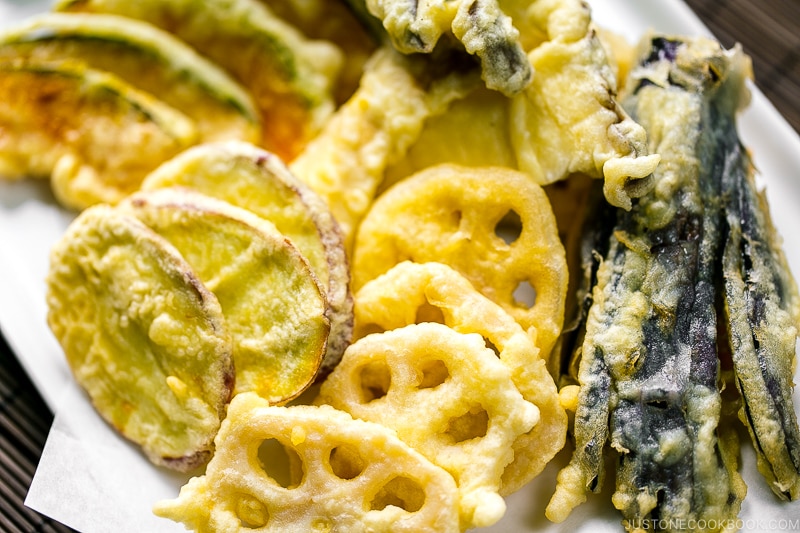
The temperature has to be between 320-356°F (160°C – 180°C) depending on how long it takes to cook through the ingredients. If it takes a long time to cook, then deep fry at a lower temperature because high temperature will cook the batter too fast and inside won’t be cooked thoroughly. And remember, cold battered ingredients will lower the oil temperature quickly; therefore, if you need to deep fry vegetables at 338°F (170°C), you need to bring the oil to 356-365°F (180-185°C) first.
How to Deep Fry Tempura
If you ask me what’s the most difficult part of making Tempura, I’d say it’s to keep the right temperature at all times while deep frying. It cannot be too high or too low. Most of the time I do not require a thermometer, but if you are not used to deep frying, I highly recommend you get a thermometer to precisely know at what temperature you are deep frying. The right sound of tempura being deep-fried is like a light sound. Like cider just being opened. That kind of light bubbly sound.

In order to maintain the correct temperature, do not overcrowd with ingredients when deep frying. As guidance remember just half of the oil surface should be covered with ingredients. When you put too many ingredients in at once, the oil temperature will drop too quickly.
What if the oil gets too hot? The quick solution to this is to add a bit of extra oil or add more cold-battered ingredients. As I said, it is all about temperature control when deep frying.
Lastly, please pick up crumbs in the oil between batches. The burnt crumb will attach to your new tempura if you don’t pick them up, and oil will get darker once the crumbs become burnt and it leaves a bad flavor in the oil.
Other Tempura Recipes
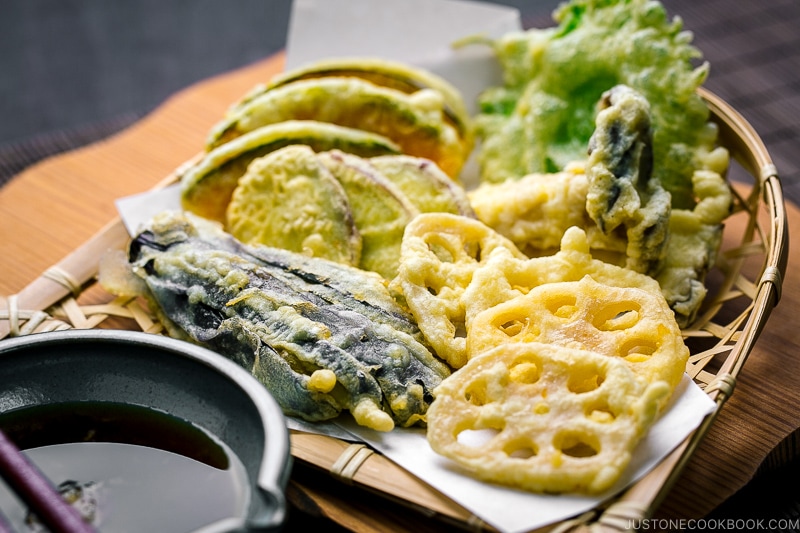
Wish to learn more about Japanese cooking? Sign up for our free newsletter to receive cooking tips & recipe updates! And stay in touch with me on Facebook, Pinterest, YouTube, and Instagram.
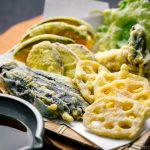
Vegetable Tempura
Ingredients
- 1 Japanese sweet potato (Satsumaimo) (unpeeled)
- ⅛ kabocha squash (unpeeled and seeded)
- 2 inches lotus root (renkon) (peeled and precooked; I used boiled lotus root (renkon no mizuni) from a Japanese grocery store)
- 2 king oyster mushrooms (eringi)
- 1 Japanese or Chinese eggplant
- 4 shiso leaves (perilla/ooba)
For the Batter
- 1 cup all-purpose flour (plain flour) (chilled; please weigh your flour; click the Metric button for weights; or learn how to measure flour with a measuring cup)
- 200 ml iced water (¾ cup + 4 tsp)
- 1 large egg (50 g each w/o shell) (chilled)
For the Dipping Sauce (Tentsuyu)
- ¾ cup dashi (Japanese soup stock) (use standard Awase Dashi, dashi packet or powder, or Vegan Dashi)
- 3 Tbsp soy sauce
- 2 Tbsp mirin
- 2 tsp sugar
For Deep-Frying
- 4 cups neutral oil (or enough for 1½ inches (3 cm) of oil in the pot; you can substitute a 10-to-1 ratio of neutral oil to sesame oil)
- all-purpose flour (plain flour) (for dusting the shiso leaves)
For Serving
- 2 inches daikon radish (grated)
Instructions
Before You Start…
- I highly encourage you to weigh your ingredients using a kitchen scale. For weights, click the Metric button above to convert the measurements to metric. If you don't have a scale, here's how to measure flour with a measuring cup: Fluff the flour with a spoon, sprinkle it into the measuring cup, and level it off. Otherwise, you may scoop more than you need.
To Make the Dipping Sauce (Tentsuyu)
- Gather the sauce ingredients.
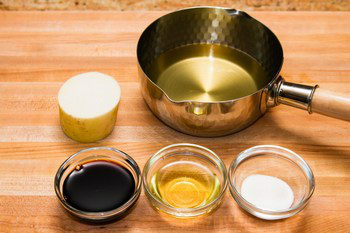
- Combine ¾ cup dashi (Japanese soup stock), 3 Tbsp soy sauce, 2 Tbsp mirin, and 2 tsp sugar in a small saucepan and bring it to a boil. Then, lower the heat and let it simmer until the sugar dissolves. Remove from the heat and set aside.
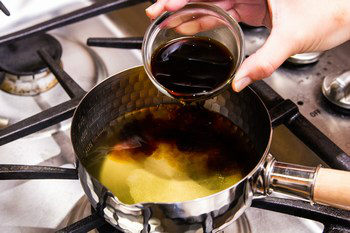
To Prepare the Vegetables
- Gather the vegetables for the tempura.
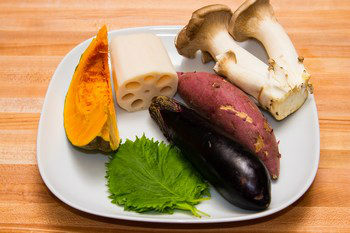
- Slice 1 Japanese sweet potato (Satsumaimo) into ¼-inch (6 mm) rounds and soak in water for 15–30 minutes to remove the excess starch. Then, pat dry with paper towels. Tip: For crispy tempura, make sure the vegetables are completely dry. Excess moisture will make the tempura soggy.
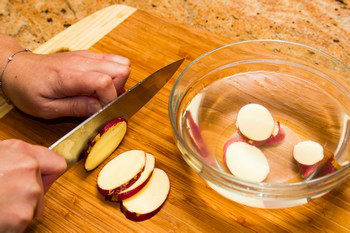
- Cut ⅛ kabocha squash and 2 inches lotus root (renkon) into slices ¼ inch (6 mm) thick. Soak the lotus root in vinegared water (2 cups water + 1 tsp vinegar) for 5 minutes. Pat them dry with paper towels.

- Cut 2 king oyster mushrooms (eringi) lengthwise into thin slices.
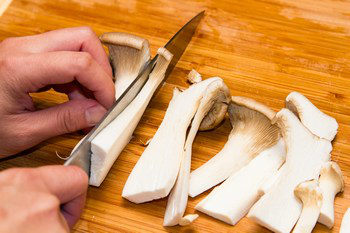
- Set aside 1 Japanese or Chinese eggplant for now; prepare it immediately before you deep-fry it. When ready, cut off the stem and calyx, then cut in half lengthwise. Place them cut side down on the cutting board. Leave the top 1 inch (2.5 cm) of the stem end intact so the eggplant stays attached, and cut the rest of it lengthwise into thin slices about ⅛ inch (3 mm) thick. Then, gently press down on the slices to fan them out. Keep the 4 shiso leaves (perilla/ooba) whole.

To Heat the Oil
- Once you've prepared the ingredients, add about 4 cups neutral oil to a depth of 1½ inches (3 cm) to a deep fryer or pot and preheat it to 320°F (160°C). Use an instant-read thermometer for precise temperature control. To check with wooden chopsticks, dip them in the oil; when small bubbles form around the tips, the oil is ready. Tip: For enhanced aroma and taste, I like to add 1 part sesame oil for every 10 parts neutral oil.
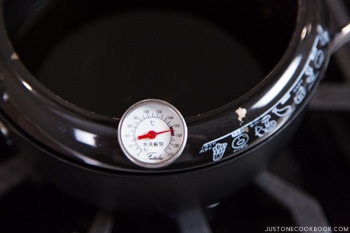
To Make the Batter
- While the oil is heating up, prepare the tempura batter. We‘ll use a 1-to-1 ratio (by volume) of flour to egg + water. Gather all the ingredients.
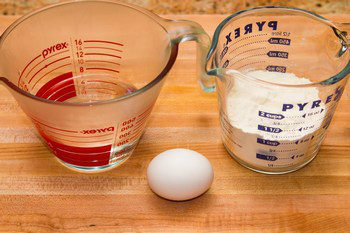
- Sift 1 cup all-purpose flour (plain flour) into a large bowl.
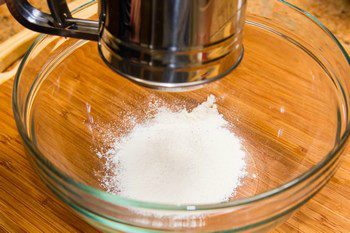
- Add 200 ml iced water to a measuring cup or bowl. Then, add 1 large egg (50 g each w/o shell).
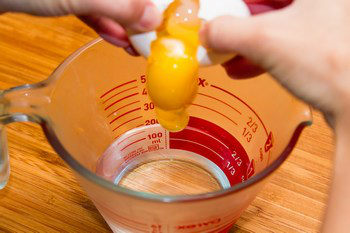
- Whisk the egg and water mixture vigorously and discard the foam on the surface.

- Slowly pour the egg mixture into the flour while mixing with chopsticks in a figure 8 pattern for about 15–20 seconds. Do not overmix to avoid activating the wheat gluten; it‘s fine to leave some lumps in the batter. Keep the batter cold at all times by adding 1–2 ice cubes to the batter or by setting the batter bowl in a larger bowl of iced water.
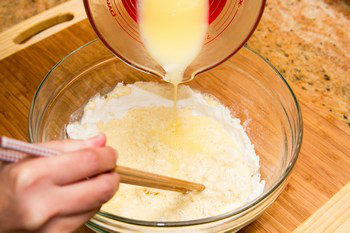
To Deep-Fry
- When the oil is heated, deep-fry the sweet potato and lotus root (the root vegetables) at 320°F (160°C) for 3–4 minutes until lightly golden. Dip one piece in the batter, let the excess drip off for 1–2 seconds, and gently place it into the hot oil. Fry in batches and do not crowd the pot. Clean the oil of fried crumbs between batches. Maintain the right temperature at all times. Tip: Your ingredients should take up no more than half of the oil's surface area because the temperature will drop quickly if you add too much food at once. For more helpful hints, read my post on how to deep-fry food.
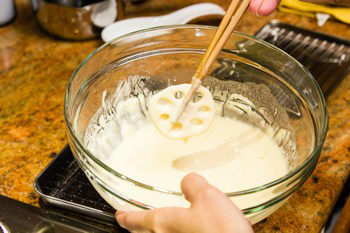
- Between batches, use a fine-mesh skimmer to remove the tempura crumbs from the oil, which will burn and turn the oil darker. Continue frying until you‘ve cooked all the ingredients.
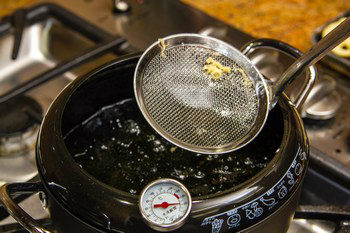
- Next, raise the oil temperature to 338–356°F (170–180°C) and deep-fry the kabocha, eggplant, and mushrooms for 1–2 minutes. Dip and add one piece at a time. Fry in batches and maintain the target oil temperature.Finally, deep-fry the shiso leaves for 15–20 seconds. To batter them, sprinkle a bit of sifted all-purpose flour (plain flour) on the back of the leaves and dip only the back of the leaf into the batter. Tip: The extra flour acts as a glue that helps the batter adhere to the shiso leaf.
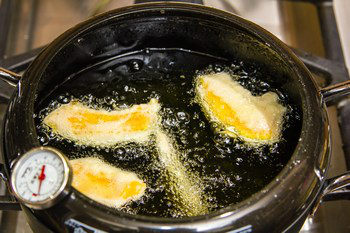
- Deep-fry until lightly golden. Transfer to a wire rack or paper towel to remove the excess oil.
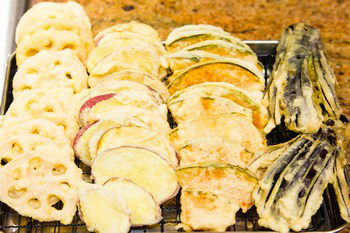
To Serve
- Peel and grate 2 inches daikon radish and gently squeeze out some of the liquid.
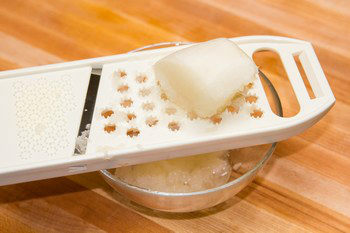
- Prepare 3–4 Tbsp of warm tentsuyu in each individual dipping bowl with 1 Tbsp grated daikon per serving on the side. Serve immediately. Mix some grated daikon into the dipping sauce for a refreshing taste and dip the tempura pieces to enjoy.

To Store
- Place the leftover tempura in a single layer between paper towels and store in an airtight container or a resealable plastic bag. Freeze up to 2 weeks. To reheat, place on a wire rack in a 400ºF (200ºC) oven or toaster oven for 5 minutes or until crisp on the outside and heated through. If you have unused dipping sauce, you can store it in the refrigerator for up to 1–2 weeks.
Nutrition
Editor’s Note: The post was originally published on Jan 20, 2013.
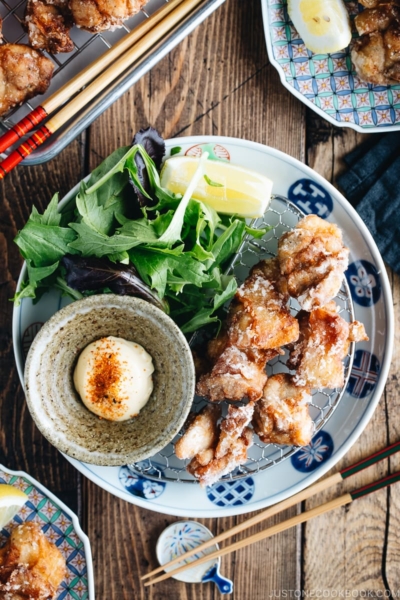
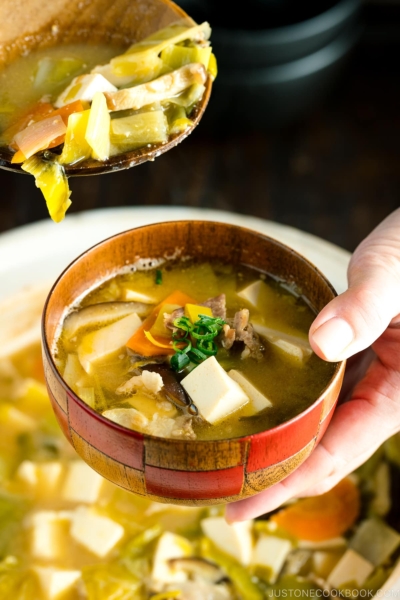
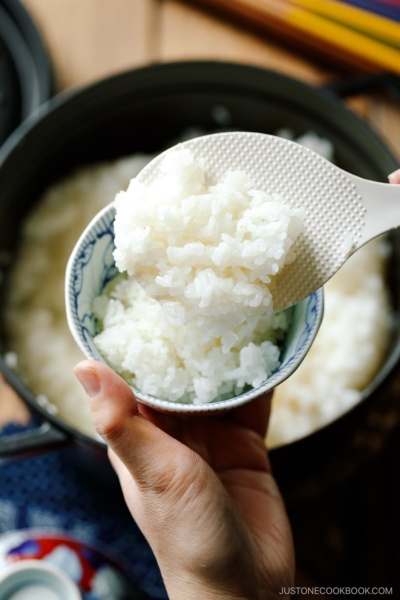






Hi, I recently heard that you can use matcha powder with salt to make tempura sauce with it. I was wondering if you have a recipe for it? I saw several recipes with just matcha powder and salt, but I didn’t know if they were authentic Japanese recipes or not.
Hi Apple Girl! Yes we enjoy it with matcha salt too. It is (good quality) matcha and salt (kosher or sea salt is great). More matcha than salt, there is no specific recipe for it, but just sprinkle some salt into matcha (not the other way around). Hope you enjoy!
I love japanese food and your website helps me a lot. Thank you
Thank you for your kind words, Yanti! xo 🙂
Nami,Thanks for our tempura batter reply,and reminding me about testing batter temp with dry chopstick oil bubbles.I have been experimenting with optimizing my batter,even farther. I always keep a bottle of cheap vodka in my freezer(not refrig.) for many uses. One use can be for deep frying batters. Substituting part of the icewater with a matching part of the freezr vodka(it will not freeze at all) will help speedup the evaporation of some of the liquid from the batter.Alchol is very volitol and evaporates much faster than water.All the alchol will be mostly evaporated at complete of complete cooking,and in theory, will help keep more crisp..at finished product.Some of British fish/chip shops also substitute cold seltzer water with the vodka ,to even farther evaporate liquid before cooking is completed. I do this often. Don
Hi Don! Yeah, it’s common to use beer and carbonated water to make deep frying batter so that the batter stays airy and crisp. I looked into traditional tempura recipes but most chefs at tempura specialized restaurants in Japan don’t use it. Personally I think it’s a really good trick, but I try to keep my recipes authentic on my blog and try to teach traditional technique… Thank you for sharing your tip with my readers though, I really appreciate it!
Nami, How frequently do Japenese cooks use a technique of drizziling the batter (tempura) over the half cooked ebi veggis,and the surface of the oil,then lastly gather-up the finished items with the very course batter drizzilings? Does this techniue have a separate nihon name?Do you think it is worth the extra step to bother with this?
Hi Don! Are you talking about home cooks or chefs? Home cooks, it really depends but most probably don’t care too much about how tempura look. They don’t need to make their tempura look like restaurants’ tempura… plus it’s extra batter = extra calories… it’s all about the look and texture.
However, tempura restaurants do that. I’ve seen them pour the batter over the oil/ingredients (and it depends on ingredients).
I don’t think there is no special name for it. Or maybe in specialized tempura restaurant world, they might, but I don’t know…
If you ask me, I don’t think extra batter is not necessary but the texture of batter is important even though you don’t have that extra batter around the ingredients.
Nami,thank you for the very thorough
reply. Oc course,I very much appreciate your interest to reply. Don
Good evening, thank you, great knowledge that you shared, very much appreciated…..
Thank you! 🙂
Hi,
I tried Tempura Vegetables and Shrimps accoding to your instructions. They were perfect !! yes we all loved it.
Wishing you much more popularity.
Lalani
Hi Lalani! I’m so happy to hear you all enjoyed the tempura! Thanks so much for your kind feedback and support! 🙂
How long do you typically fry each piece of vegetable? (2 min?)
Hi Kaori! I updated my recipe with cooking time:
For root vegetables, deep fry at 320°F (160°C) for 3-4 minutes. For vegetables and mushrooms, at 338-356°F (170-180°C) for 1-2 minutes.
Hope this helps! 🙂
Sorry, but has this been translated into English with Google Translate? It’s pretty hard to follow… Love the pictures, and the basic explanation, but certainly not the best tempura recipe I’ve ever read – with some blatant mistakes even.
Hi Amys! I do not use google translate to write my post/recipe even though English is my second language. Basic Tempura recipe is very simple and pretty much same (or just slightly different) in every household in Japan. However what makes tempura special is the deep fry skill. It took me quite some time to get to where I am in terms of my tempura making and I feel I still need to improve my skill looking at these photos. There are tempura specialized restaurants/chefs and they make excellent tempura that it’s hard for me to achieve. I use this recipe all the time and I’m sorry to hear it didn’t work for you. There are a lot of Japanese who don’t make tempura at home because it’s not “easy” to make a perfect looking/texture tempura. So hope you won’t give up with your first try! 🙂
Your English is completely legible and understandable. I had no problems understanding you and thank you for taking the effort to learn English well enough to publish an entire blog and respond to people’s comments. Not many English speakers could do the same in Japanese! 🙂 I can’t wait to try this tempura, I have many fond memories of my father’s friend Junichi-san sitting and making us batch after batch. As many have noticed, tempura is best served when piping hot so the tempura chef doesn’t get any rest. 🙂
Hi L Rozelle! Thank you so much for your kind words. I’m glad to hear my recipes are okay. 🙂 It’s a lot of work for a host to serve tempura as it’s impossible to eat together at the table. My mom always wishes to go to tempura shop for a special occasion so she can enjoy tempura sitting down, instead of being busy serving for the family. Thank you for sharing your sweet Japan story!
je n’ai jamais fait Tempura, en regardant vos conseils de préparations, c’est vraiment simple et géniale. Et je vous remercie beaucoup
Bonjour Faehau! Merci! 🙂
Lovely , Lovely crispy shrimp and vegetable tempura. Can I use any other leafy green vegetables.
Hi Imelda! Hmmm leafy green vegetables are quite hard to deep fry as the oil temp is pretty high and the leafy vegetable will be cooked instantly (like shiso leaves are very quick to be deep fried). I recommend non-leafy vegetables such as broccoli, carrot, potatoes, asparagus, etc… 🙂
Hi, I want to make this Tempura tonight-don’t understand what (egg water is?) can you let me know before 7pm
Dolores, egg water is a mixture of egg and water.
To make 1 cup (240 ml) egg water, you will need to combine 1 cold large egg (40ml) and 200 ml ice water.
Not sure where you are located, but I hope I responded before 7pm. 🙂
I live in California, thank you for responding on time, I have all the stuff ready, and soon I will start cooking, will let you know how my guests liked it/thank you again
Hi,nami.I like your recipe so much.and your explanation, is great,I learned many things from you. Thanks!But, I’m living in a small town of Spain, can’t found the asia ingredients over here.I had tried CHEESECAKE,DORAYAKI …from here.well,finally was OK,I think so.At least someone said it was good.jeje.And now I have a problem,hope you can help me,please.My son is 2 and half years old.I’m trying to make some food for him evrytime.Like eegs, meatball with the sauce.noodles… But that’s difficult.He didn’t eat well.Just the rice,thin noodles,eggs.He doesn’t like the vegetables,shrimps,some kind of fish.I hope he can like to try everything.I don’t know what can I do for him? So, could you tell me some advice,please.
Hi Joanna! I’m really happy to hear you enjoy my blog and thanks for your time to write here.
As for your son, it’s hard to advise without knowing more details, but I would suggest to include tiny bit of “challenging” item in his favorite food. Don’t include a lot – start tiny portion, that’s almost not visible…or almost non sense. You can always increase the portion when he’s more “comfortable” with flavor and the look. The point here is to encourage him to eat the one he doesn’t like. He and his tongue will get used to the flavor and texture, and he will also get used to eating things that he doesn’t like. After a while it will be “normal” for him to eat that challenging ingredient.
I also recommend to keep rotating his menu. Try not to feed the same food, because one day he’ll say he doesn’t want to eat anything else but the food you are giving to him. It’s better now to show him that we eat different things.
Also, prepare some little treat (not like candy). For us, it was a gummy vitamins. We would give them anyway, but we pretended it was a treat saying that they won’t get any if they don’t eat everything.
Hope that helps? 🙂
I LOVE vegetable tempura!!! I’ve never cooked it before but with your recipe and tips I intend to give it a go. Thank you for providing such clear instructions. I am not surprised your cheesecake recipe is the most popular. You can just tell from the photo it’s heavenly. I’ll be making your cheesecake for my upcoming birthday in a few weeks time along with other savoury recipes. My theme for the party is Japanese food 🙂
Hi Marianna! Thank you for your kind feedback. I hope you enjoy my tempura batter! It’s delicious and the texture should come out well if you are pretty good at deep frying. 🙂 Cheesecake is very popular among bakers. I should be baking more often. 🙂
Soo perfect! Normally i don’t like tempura but seeing yours making me change my mind.
You don’t like tempura? I wish I can change your mind totally. 🙂
Looks fantastic. Just one more question: how do you keep the fried tempura hot? The few times I tried to make it, we just ate every fried batch and went back to the kitchen. Not ho good, if you want to make it for guests. Any suggestions? Thanks!!
Hi Lara! Ideally, Tempura should be eaten right after deep fried. I’d deep fry the amount you serve first, then do a second batch (for second round) if it’s for guests. Otherwise you just have to drain excess oil from the tempura after fried. Placing tempura vertically helps to drain excess oil. Use wire rack rather than paper towel, so bottom is not going to be soggy. When you serve, re-heat using a toaster oven and that helps in terms of crispiness. Hope this helps!